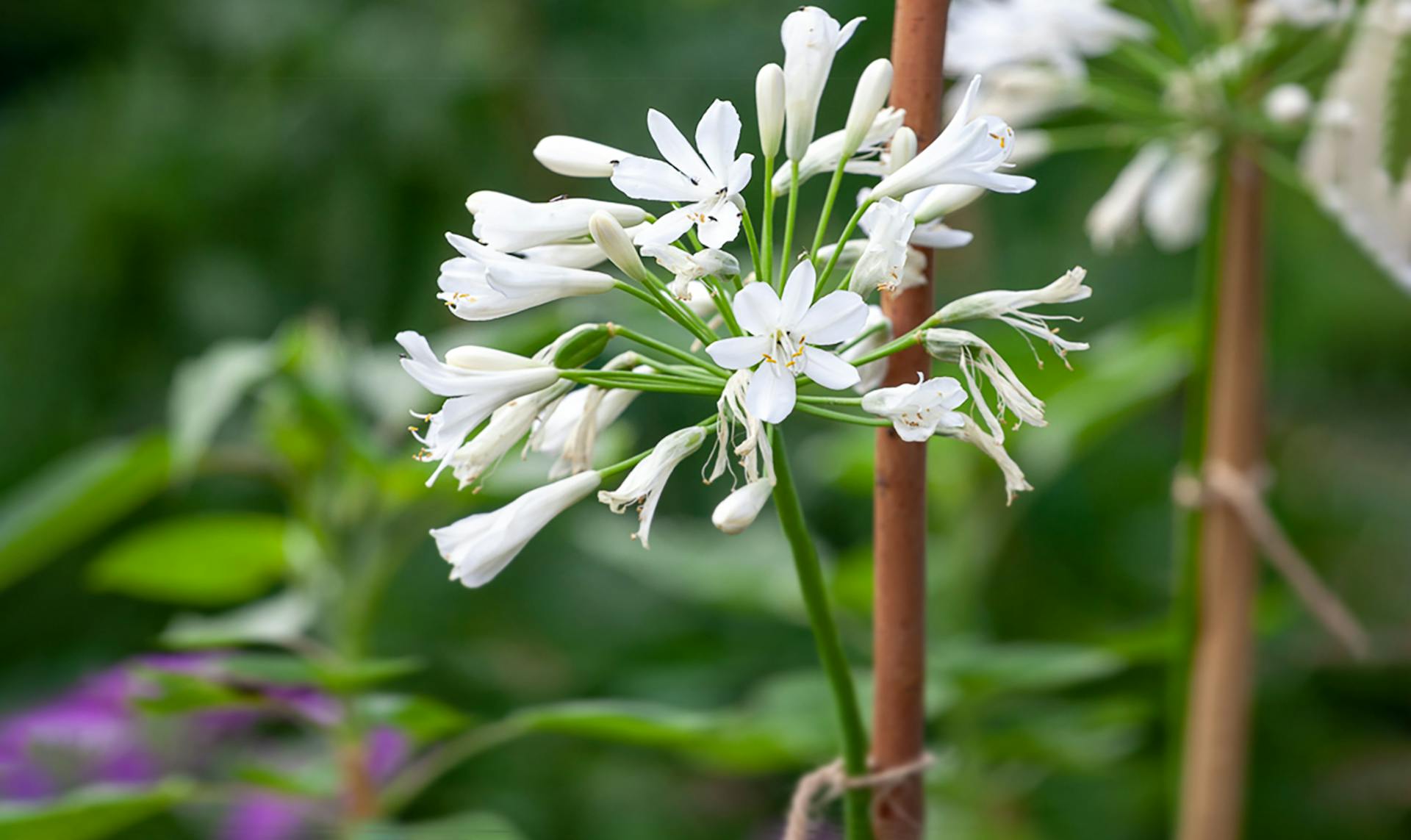how to plant, grow & care for agapanthus
complete growing guide
Agapanthus are brilliant plants for summer borders, offering structure, drama, elegance and grace. They also look great in a series of pots lining a path or the edge of a terrace. There are whoppers standing over 1m (4ft) tall, down to more compact varieties at half that size, which make them ideal for small container gardens. Their colours are fantastic, ranging from bright blues and vivid purples to subtle whites and bi-colours. To find the right plant for your space, take a look at our range of agapanthus plants.
details
- Common name: African Lily
- Latin name: Agapanthus
- Type: Perennial - Agapanthus can be evergreen or deciduous
- Height: There are some compact varieties of agapanthus that reach around 20cm (8in) to 50cm (1.5ft). Taller varieties can get up to over 1m (4ft)
- TLC rating: Easy
- Aspect: Full Sun
- Planting position: Borders, Containers
- Suitable for pots: Yes
- Good for pollinators: Yes
- Good for cut flowers: Yes
calendar
how to grow agapanthus

where to grow agapanthus
Soil type: Agapanthus grow best in well-drained soil. On heavy soils, mix in grit when planting.
Aspect & position: Choose a sunny site that receives sun for most of the day – agapanthus thrive in full-sun and prefer a sheltered position.
when to plant agapanthus
Plant agapanthus in spring, ideally in March or April. Some varieties can be planted in September.
how to plant agapanthus
growing agapanthus in borders
Spring is the best time to plant your agapanthus in a sunny, sheltered position. Incorporate grit into poorly drained soils and plant with the crown just below the soil surface.
Agapanthus are either deciduous or evergreen, the deciduous types are hardiest, losing their leaves and dying down in winter and reemerging in spring. Once they are established, they should withstand most conditions. However, I’d still advise mulching the plants in autumn/winter or covering the crown of the plant with straw or fleece to protect them from cold.
Evergreen types are more tender and their leaves can be damaged by frosts so they will need good protection over winter. Evergreen types in pots should be brought undercover over winter. If your agapanthus are in the ground, a mulch of straw or fleece is essential (unless you live in South-West England).
Established clumps of agapanthus can withstand -10ºC to -15ºC if the ground is well drained, but the number of flowers may be reduced the following summer. Planting in beds in a sheltered position (for example, against house walls) can reduce the likelihood of frost damage. If your soil gets water-logged, consider planting in containers.
Agapanthus can be reluctant to flower if subjected to drought conditions after flowering. To ensure a good display the following year, keep plants moist until autumn, which will encourage the development of new flower buds. Cut down spent flower stems so that the plant concentrates on flower bud formation rather than seed production.
It may take two or three years for plants to establish before flowering really takes off, but after this they will grow into long-flowering clumps. If clumps become too big, they can be lifted and split every four to five years.

growing agapanthus in a pot
Agapanthus perform best where root development is restricted, as restricted roots encourage flower formation. This makes agapanthus well suited to being grown in pots, especially the evergreen types which can then be brought into a conservatory or greenhouse for the winter.
Agapanthus don't like to be planted into pots that are too spacious as this will encourage leaf growth rather than flower production. Ideally, they perform best where root development is restricted but the plants are well watered and fed. Try two or three plants to a medium-sized pot, around 30cm (12in) in diameter.
You will need to re-pot your plants in two or three years’ time so choose a pot with straight sides which will make removal of the rootball easier.
Use a loam based compost like John Innes No3 and include one part horticultural grit or gravel. Plant with the crown just below the soil compost.
Ensure that you feed them during the growing season. Feed weekly or fortnightly with a balanced liquid feed during the growing season until flowers begin to show colour.
If the plants become root bound, split and replant in fresh compost.
how to care for agapanthus
watering
Agapanthus need to be consistently moist between April and September. If the plants are in pots they will need to be brought undercover in October and they will require very little water until spring.
Newly planted agapanthus need to be watered regularly. This is particularly important for agapanthus in containers, which dry out more quickly than those in the ground. Agapanthus do not like to sit in water-logged soil.
fertilising
If you’re growing agapanthus in containers, feed with a high potassium fertiliser, such as comfrey pellets, monthly from spring until flowering.
deadheading
Cut back the flower stems when flowering is over so the plant spends its energy on flower bud formation for the following year. You could leave some seedheads on established plants for their architectural look.

propagating
Agapanthus plants can be lifted and divided once they have formed established clumps. It may take two or three years for plants to establish into long-flowering clumps, but once this happens they can be lifted and split every four to five years.
Agapanthus in pots can also be lifted and divided. Although plants flower well in pots if the roots are constricted, they should not be allowed to become completely root bound and should be split and replanted in fresh compost if the roots become too congested.
overwintering
Evergreen agapanthus in pots can be brought undercover in a greenhouse or cold frame in October. Deciduous agapanthus in the garden should be protected with a good mulch of straw or horticultural fleece.
seasonal checklist
spring
- If your agapanthus are in pots, feed with a high potassium fertiliser, such as comfrey liquid from April until August.
summer
- Make sure you continue to water your agapanthus regularly.
autumn
- Cut back the flower stems when flowering is over so the plant spends its energy on flower bud formation.
- Or, enjoy the architectural seedheads on your agapanthus plants.
winter
- Ensure that your agapanthus plants are fully protected from the cold (though deciduous types can withstand –10ºC to –15º once established). Mulch or cover the crown of the plant with straw or fleece. Evergreen types need to come undercover in a greenhouse or cold frame.
pests, diseases & common issues
gall midge
The agapanthus gall midge is a very small fly. The tiny midges lay eggs in agapanthus flower buds which can lead to flower discolouration, buds failing to open and even the whole flowerhead collapsing. If you suspect a flowerhead is infested, check for creamy orange maggots in the flowerbuds. Then cut off and destroy any affected parts of the plant. Sometimes, you might have to sacrifice the whole plant.

why are my agapanthus leaves turning yellow?
Agapanthus leaves will turn yellow and die back in autumn and winter, which is a totally normal part of the growth cycle.
If you’ve got yellow leaves but green veins, this could indicate an iron or magnesium deficiency.
Root rot (brought about by water-logged soil) can also lead to yellowing leaves – dig up the plant and check to see if the roots are discoloured and soft.
why is my agapanthus drooping?
Overwatering can cause root rot, which in turn can show up as drooping and wilting leaves. Check the roots and replant any healthy looking sections in fresh compost.
Underwatering can also cause drooping, check the soil by sticking your finger in it to gauge how damp it feels.
why is my agapanthus not flowering?
Frost may have affected the plant over winter, reducing flowering the following summer. Another thing to consider is the roots – if you have planted your agapanthus in a large pot, you will likely get lots of leaves and very few flowers, while restricted roots in a smaller pot encourage flower formation.
If the agapanthus is in a pot, underwatering and lack of fertiliser may also reduce flowering the following season.
frequently asked questions
are agapanthus poisonous?
Agapanthus has a toxic sap which can irritate skin. Avoid contact with the sap by wearing gloves when handling the plant.
are agapanthus evergreen?
Some are evergreen, others are deciduous. Evergreen types need to be brought undercover over winter.
are agapanthus frost hardy?
Deciduous types are hardy, evergreen types are not fully hardy.
are agapanthus better in pots?
Agapanthus are ideal for containers. A pot naturally restricts their roots and this encourages flower formation. They are also easier to move to sheltered positions, or brought undercover over winter, if they are in containers.
can agapanthus change colour?
Seeds self-sown around the base of the plant may develop flowers that are a different colour to the parent plant.
where do agapanthus come from?
Agapanthus is native to South Africa.
can agapanthus be moved?
Agapanthus plants can be lifted and divided once they have formed established clumps. It may take two or three years for plants to establish into long-flowering clumps, but once this happens they can be lifted and split every four to five years.
do you cut back agapanthus in winter?
Deciduous types can be cut back hard, evergreen types can be left as they are and tidied up in spring.
are agapanthus drought tolerant?
In pots, agapanthus need to be kept consistently moist between April and August. But, once established in the ground, agapanthus are relatively drought tolerant.
how to cut & arrange agapanthus

Agapanthus make dramatic cut flowers. One or two stems alone in a vase make a striking display, while just three stems can bring structure and a focal point to a simple arrangement.
Get more inspiration for displaying your flowers with our flower arranging videos:







